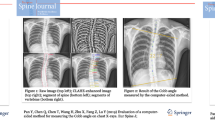Abstract
Pre-operative diagnosis of chest-wall deformity is important for successful surgical correction and post-operative evaluation of funnel chest patients. However, conventional indices that define the severity of deformity have several limitations; manually calculated and cannot supply information about asymmetry. We developed four indices that can represent both the depression and the asymmetry of the chest-wall, and can automatically be extracted by computerized image processing technique. Three indices, including eccentricity index (EI), flatness index (FI), and circularity index (CI), were suggested to represent the depression of the chest-wall, and one index, rotation index (RI), to represent the asymmetry of the chest-wall. To verify the feasibility of new indices, several synthetic images and real CT images were used to analyze the performance of new indices and the statistical relationship with conventional Haller index. The experimental results showed possible application of suggested indices to the diagnosis of funnel chest patient. Suggested indices showed clear trends of change with the severity of chest-wall deformation in regards to both the depression and the asymmetry. Results of statistical analysis showed high correlation between new indices and HI, showing possibility of replacing HI.






Similar content being viewed by others
References
Backer OG, Brunner S, Larsen V (1961) Radiologic evaluation of funnel chest. Acta Radiol 55:249–256
Crump HW (1992) Pectus excavatum. Am Fam Physician 46:173–179
de Matos AC, Bernardo JE, Fernandes LE, Antunes MJ (1997) Surgery of chest wall deformities. Eur J Cardiothorac Surg 12:345–350. doi:10.1016/S1010-7940(97)00168-1
Donnelly LF, Frush DP (1999) Abnormalities of the chest wall in pediatric patients. AJR Am J Roentgenol 173:1595–1601
Fonkalsrud EW, Dunn JC, Atkinson JB (2000) Repair of pectus excavatum deformities: 30 years of experience with 375 patients. Ann Surg 231:443–448. doi:10.1097/00000658-200003000-00019
Gander W, Golub GH, Strebel R (1994) Fitting of circles and ellipses least squares solution. BIT 34:558–578. doi:10.1007/BF01934268
Golladay ES, Golladay GJ (1997) Chest wall deformities. Indian J Pediatr 64:339–350. doi:10.1007/BF02845203
Haller JA Jr, Kramer SS, Lietman SA (1987) Use of CT scans in selection of patients for pectus excavatum surgery: a preliminary report. J Pediatr Surg 22:904–906. doi:10.1016/S0022-3468(87)80585-7
Haller JA Jr, Scherer LR, Turner CS, Colombani PM (1989) Evolving management of pectus excavatum based on a single institutional experience of 664 patients. Ann Surg 209:578–582. doi:10.1097/00000658-198905000-00010
Haralick RM, Shapiro LG (1992) Computer and robot vision. Addison-Wesley Longman Publishing Co., Inc., USA
Lee CS, Park HJ, Lee SY (2004) New computerized tomogram (CT) indices for pectus excavatum: tools for assessing modified techniques for asymmetry in nuss repair. Chest Suppl 126(4):777s
Ohno K, Nakahira M, Takeuchi S, Shiokawa C, Moriuchi T, Harumoto K et al (2001) Indications for surgical treatment of funnel chest by chest radiograph. Pediatr Surg Int 17:591–595. doi:10.1007/s003830100000
Ohno K, Morotomi Y, Nakahira M, Takeuchi S, Shiokawa C, Moriuchi T et al (2003) Indications for surgical repair of funnel chest based on indices of chest wall deformity and psychological state. Surg Today 33:662–665. doi:10.1007/s00595-003-2575-6
Park HJ (2007) Technical innovations in minimally invasive approach for pectus excavatum: a paradigm shift through a six-year experience with 630 patients. Innovations 2(1):25–28
Park HJ, Lee SY, Lee CS, Youm W, Lee KR (2004) The Nuss procedure for pectus excavatum: evolution of techniques and early results on 322 patients. Ann Thorac Surg 77:289–295. doi:10.1016/S0003-4975(03)01330-4
Saxena AK, Schaarschmidt K, Schleef J, Morcate JJ, Willital GH (1999) Surgical correction of pectus excavatum: the Munster experience. Langenbecks Arch Surg 384:187–193. doi:10.1007/s004230050190
Suita S, Taguchi T, Masumoto K, Kubota M, Kamimura T (2001) Funnel chest: treatment strategy and follow-up. Pediatr Surg Int 17:344–350. doi:10.1007/s003830000575
Xu C, Prince JL (1998) Snakes, shapes, and gradient vector flow. IEEE Trans Image Process 7:359–369. doi:10.1109/83.661186
Acknowledgments
This study was supported by a grant from the Korea Health 21 R&D Project of the Ministry of Health and Welfare (Grant No. A020609) and the Brain Korea 21 Project of the Ministry of Education and Human Resources Development, Republic of Korea. This research was carried out with support from the Image Analysis Technological Foundation Planning and Development Board of the Korean Institute of Science and Technology Evaluation and Planning, Republic of Korea (M10429040003-04L2904-00310). This work was supported by Grant No. R01-2006-000-11368-0 from the Basic Research Program of the Korea Science and Engineering Foundation.
Author information
Authors and Affiliations
Corresponding authors
Rights and permissions
About this article
Cite this article
Kim, H.C., Park, H.J., Ham, S.Y. et al. Development of automatized new indices for radiological assessment of chest-wall deformity and its quantitative evaluation. Med Biol Eng Comput 46, 815–823 (2008). https://doi.org/10.1007/s11517-008-0367-2
Received:
Accepted:
Published:
Issue Date:
DOI: https://doi.org/10.1007/s11517-008-0367-2




